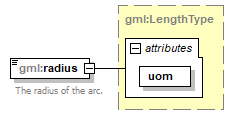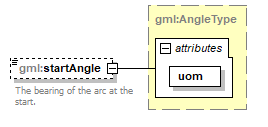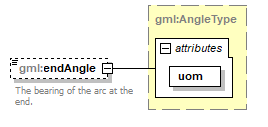| diagram |  |
||||||||||||||||||||||||||||||||||||||||||||||
| namespace | http://www.opengis.net/gml | ||||||||||||||||||||||||||||||||||||||||||||||
| type | extension of gml:AbstractCurveSegmentType | ||||||||||||||||||||||||||||||||||||||||||||||
| properties |
|
||||||||||||||||||||||||||||||||||||||||||||||
| children | gml:pos gml:pointProperty gml:pointRep gml:posList gml:coordinates gml:radius gml:startAngle gml:endAngle | ||||||||||||||||||||||||||||||||||||||||||||||
| used by |
|
||||||||||||||||||||||||||||||||||||||||||||||
| attributes |
|
||||||||||||||||||||||||||||||||||||||||||||||
| annotation |
|
||||||||||||||||||||||||||||||||||||||||||||||
| source | <xs:complexType name="ArcByCenterPointType"> <xs:annotation> <xs:documentation>This variant of the arc requires that the points on the arc have to be computed instead of storing the coordinates directly. The control point is the center point of the arc plus the radius and the bearing at start and end. This represenation can be used only in 2D.</xs:documentation> </xs:annotation> <xs:complexContent> <xs:extension base="gml:AbstractCurveSegmentType"> <xs:sequence> <xs:choice> <xs:annotation> <xs:documentation>GML supports two different ways to specify the control points of a curve segment. 1. A "pos" (DirectPositionType) or "pointProperty" (PointPropertyType) element. The "pos" element contains a center point that is only part of this curve segment, a "pointProperty" element contains a point that may be referenced from other geometry elements or reference another point defined outside of this curve segment (reuse of existing points). 2. The "posList" element can be used to specifiy the coordinates of the center point, too. The number of direct positions in the list must be one.</xs:documentation> </xs:annotation> <xs:choice> <xs:element ref="gml:pos"/> <xs:element ref="gml:pointProperty"/> <xs:element ref="gml:pointRep"> <xs:annotation> <xs:documentation>Deprecated with GML version 3.1.0. Use "pointProperty" instead. Included for backwards compatibility with GML 3.0.0.</xs:documentation> </xs:annotation> </xs:element> </xs:choice> <xs:element ref="gml:posList"/> <xs:element ref="gml:coordinates"> <xs:annotation> <xs:documentation>Deprecated with GML version 3.1.0. Use "posList" instead.</xs:documentation> </xs:annotation> </xs:element> </xs:choice> <xs:element name="radius" type="gml:LengthType"> <xs:annotation> <xs:documentation>The radius of the arc.</xs:documentation> </xs:annotation> </xs:element> <xs:element name="startAngle" type="gml:AngleType" minOccurs="0"> <xs:annotation> <xs:documentation>The bearing of the arc at the start.</xs:documentation> </xs:annotation> </xs:element> <xs:element name="endAngle" type="gml:AngleType" minOccurs="0"> <xs:annotation> <xs:documentation>The bearing of the arc at the end.</xs:documentation> </xs:annotation> </xs:element> </xs:sequence> <xs:attribute name="interpolation" type="gml:CurveInterpolationType" fixed="circularArcCenterPointWithRadius"> <xs:annotation> <xs:documentation>The attribute "interpolation" specifies the curve interpolation mechanism used for this segment. This mechanism uses the control points and control parameters to determine the position of this curve segment. For an ArcByCenterPoint the interpolation is fixed as "circularArcCenterPointWithRadius".</xs:documentation> </xs:annotation> </xs:attribute> <xs:attribute name="numArc" type="integer" use="required" fixed="1"> <xs:annotation> <xs:documentation>Since this type describes always a single arc, the attribute is fixed to "1".</xs:documentation> </xs:annotation> </xs:attribute> </xs:extension> </xs:complexContent> </xs:complexType> |
attribute ArcByCenterPointType/@interpolation
| type | gml:CurveInterpolationType | ||||||||||||||||||||||||||||||||||||
| properties |
|
||||||||||||||||||||||||||||||||||||
| facets |
|
||||||||||||||||||||||||||||||||||||
| annotation |
|
||||||||||||||||||||||||||||||||||||
| source | <xs:attribute name="interpolation" type="gml:CurveInterpolationType" fixed="circularArcCenterPointWithRadius"> <xs:annotation> <xs:documentation>The attribute "interpolation" specifies the curve interpolation mechanism used for this segment. This mechanism uses the control points and control parameters to determine the position of this curve segment. For an ArcByCenterPoint the interpolation is fixed as "circularArcCenterPointWithRadius".</xs:documentation> </xs:annotation> </xs:attribute> |
attribute ArcByCenterPointType/@numArc
| type | xs:integer | ||||||
| properties |
|
||||||
| annotation |
|
||||||
| source | <xs:attribute name="numArc" type="integer" use="required" fixed="1"> <xs:annotation> <xs:documentation>Since this type describes always a single arc, the attribute is fixed to "1".</xs:documentation> </xs:annotation> </xs:attribute> |
element ArcByCenterPointType/radius
| diagram |  |
||||||||||||
| namespace | http://www.opengis.net/gml | ||||||||||||
| type | gml:LengthType | ||||||||||||
| properties |
|
||||||||||||
| attributes |
|
||||||||||||
| annotation |
|
||||||||||||
| source | <xs:element name="radius" type="gml:LengthType"> <xs:annotation> <xs:documentation>The radius of the arc.</xs:documentation> </xs:annotation> </xs:element> |
element ArcByCenterPointType/startAngle
| diagram |  |
||||||||||||
| namespace | http://www.opengis.net/gml | ||||||||||||
| type | gml:AngleType | ||||||||||||
| properties |
|
||||||||||||
| attributes |
|
||||||||||||
| annotation |
|
||||||||||||
| source | <xs:element name="startAngle" type="gml:AngleType" minOccurs="0"> <xs:annotation> <xs:documentation>The bearing of the arc at the start.</xs:documentation> </xs:annotation> </xs:element> |
element ArcByCenterPointType/endAngle
| diagram |  |
||||||||||||
| namespace | http://www.opengis.net/gml | ||||||||||||
| type | gml:AngleType | ||||||||||||
| properties |
|
||||||||||||
| attributes |
|
||||||||||||
| annotation |
|
||||||||||||
| source | <xs:element name="endAngle" type="gml:AngleType" minOccurs="0"> <xs:annotation> <xs:documentation>The bearing of the arc at the end.</xs:documentation> </xs:annotation> </xs:element> |
XML Schema documentation generated by XMLSpy Schema Editor http://www.altova.com/xmlspy